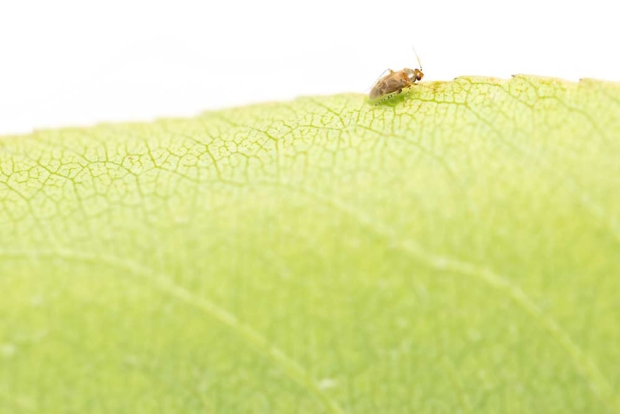
Pear psylla in 2016 to 2017 was “the worst in a decade,” Bob Gix, horticulturist for Blue Star Growers, said. Psylla don’t directly feed on pear fruit. Instead the sticky honeydew they excrete marks fruit and makes a sticky mess that is no fun for pickers.
After multiple difficult psylla years, growers in Washington’s Wenatchee River Valley were looking for answers. “Our materials are becoming less effective at an accelerating rate,” said one grower. Growers were spending more and more on sprays and still not always getting the control they need. Another grower said he used to spray $800 to $1,000 an acre but now has to spend $1,800 to $2,000 an acre.
“Each year the costs to achieve control of psylla grow and the control worsens,” Neil Johnson, field staff at Chamberlin Agriculture, said in 2017.
Unique pressure
In pear-growing regions outside the Wenatchee River Valley, psylla pressure is often low. Psylla is considered an induced pest, which means problems flare when the natural enemies that normally keep it in check are not at high enough levels.
“The big problem is we are dealing with a monoculture of pears in the Wenatchee River Valley,” said Louis Nottingham, Washington State University entomologist.
In other regions, pears are often interspersed with cherries, apples or other crops. Because of the number of acres of pears in close proximity and the limited refuge for natural enemies in apple or cherry orchards that might be sprayed at different intervals, the psylla population has built up to extremely high levels in the valley.
Psylla are also highly mobile and will move from orchard to orchard, making control a community problem.
A team effort

In 2016, researchers, growers and consultants got together to work on new integrated pest management strategies for pears. The group prioritized testing new spray programs that focus on “soft” or selective compounds with less impact on natural enemies. Now, a group of 20 growers and consultants meets with researchers twice a year to review what we have learned and update the plan for the next year.
With funding from the Washington State Department of Agriculture and the Fresh Pear Committee of the Washington Tree Fruit Research Commission, the group is learning a lot.
Getting to know the good guys
Every week from April to October, WSU Extension’s Chris Strohm scouts 20 pear orchards, from Monitor to Leavenworth, counting numbers of natural enemies, psylla and mites. Our goal is to track which spray programs are working to maintain natural enemy populations and control psylla. A few all-star natural enemies are seen in many of the pear orchards — deraeocoris, campylomma, trechnites and lacewings.
Deraeocoris brevis is a small black true bug, about one-third the width of a penny. These predators eat soft-bodied insects, including spider mites, pear psylla and mealybugs, by using their piercing mouthparts to suck out the insides of their prey. One young deraeocoris can eat 400 pear psylla eggs before it becomes an adult.
In the current project, Strohm and I began seeing overwintering adults in beat trays and traps when we started scouting in early April, and nymphs a few weeks later. From June until the end of the season, we found both adults and nymphs in beat trays in orchards with IPM or organic management. In one orchard, we counted a deraeocoris in every beat tray sample during the peak of the season.
Campylomma verbasci is considered a pest in apples, but pear growers think they may have the most potential for keeping psylla in check. A single campylomma can eat 600 psylla eggs during development. We saw nymphs starting around pear bloom and documented three generations.
Trechnites insidiosus is an important parasitoid of pear psylla. In previous studies, they have parasitized half of psylla nymphs in IPM systems. In the current study, during bloom, populations skyrocketed up to 133 per sticky card trap in some blocks. Second and third generations were in early June and August to September.
Earwigs were uncommon in this study, found only in organic orchards, even though researchers think they are important. With only one generation per year and being a nonflyer, if their population is knocked back by pesticides, it can take them a long time to recolonize an orchard.
Both brown and green lacewings are considered important natural enemies. Known as “aphid lions,” the larvae are great predators of soft-bodied insects such as psylla. Interestingly, lacewing adults were found in conventional as well as organic and IPM systems, but the predacious larvae were only numerous in organic and IPM blocks.
Identifying spray programs that work
In 2017, six collaborating orchards used IPM programs that avoided compounds known to be toxic to natural enemies. By tracking the natural enemies and psylla populations, researchers are learning whether these bio-based IPM programs can be successful.
“So far we see that the selective IPM programs are definitely growing natural enemy populations,” Strohm said. “We are surprised to see those populations bounce back so quickly, even in the first year after transition.”
Populations are not as high as in the organic plots, but they are getting there. Counts of psylla nymphs show that in organic systems, psylla pressure stayed under control all season. In IPM blocks, psylla nymph numbers started out high but dropped back down and, by harvest, were similar to the conventional fields.
In short, natural enemies are doing the work late-season. Unlike sprays that can’t penetrate thick canopies late season, they don’t care about coverage.
Refining IPM programs
Through Nottingham’s research, working with WSU’s Elizabeth Beers, WSU is making great strides toward finding solutions to improving IPM programs.
In the early season, it is critical to slow the invasion of psylla. Nottingham’s studies show that two early applications of kaolin clay products are very effective at helping start the season at a low population of psylla. Lime sulfur at delayed-dormant can also help lower adult numbers.
“Esteem is an effective product, but it may be getting used too early,” Nottingham said. When Esteem hits adult psylla, they will lay infertile eggs, but this effect only lasts eight to 10 days and it does not kill adults. “Esteem sprayed at delayed-dormant will not do much, but it is very effective near pink timing because it is closer to the peak egg-lay during bloom time,” he said.
Postbloom is a critical time for natural enemy population growth. Nottingham suggests a strategy of “pounding them with pillows.”
Multiple sprays of less disruptive products such as Centaur, diatomaceous earth, azadiractin and Cinnerate can be effective without interrupting natural enemy populations. But they only work if soft programs for other pests are also used, most importantly codling moth.
Nottingham strongly recommends starting with mating disruption for codling moth, then this pest can be controlled with selective materials such as oil, Intrepid and Cyd-X, which will not disrupt natural enemies.
“We cannot think of management in terms of individual pests; we need a full-system approach,” he said. “If we kill natural enemies with codling moth sprays, then we’ll likely see higher psylla numbers.”
In the late season, what growers need to use in this bio-based IPM system will depend on the numbers they are finding in their psylla and natural enemy counts. In some orchards employing bio-based IPM, growers have had to spray little in late season.
Another late-season tool can be tree washing, used strategically one or two times, to remove psylla honeydew from fruit. A separate overhead sprinkler system used solely for honeydew washing (while undertree sprinklers remain for irrigation) works like an insurance policy for pear psylla. Methods such as tree washing lower the need for broad-spectrum sprays later in the season and allow natural enemies to continue their work into the fall.
“Our goal as a community should be to have as many natural enemies in the fall as possible. That is how we will reduce region-wide overwintering psylla populations, saving everyone time and money the following year,” Nottingham said.
Summary
It is too early to know the potential adoption and impacts of new programs, but growers are already making changes.
“In 2018, Wenatchee Valley growers were more disciplined with early Surround, most making two to three applications, and had better psylla control,” grower Ray Schmitten said.
On the downside, other growers commented that IPM programs required two more sprays.
Stay tuned to see how psylla control evolves in one of the densest pear-growing regions in the world.
For more information visit treefruit.wsu.edu/crop-protection/pear-ipm/ •
—by Tianna DuPont
DuPont is a tree fruit extension specialist at the Washington State University Tree Fruit Research and Extension Center in Wenatchee, Washington.






Leave A Comment